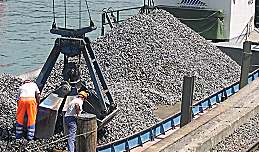Gravel
|
|

Gravel is rock that is of a certain size range. In geology, gravel is any loose rock that is at least two millimeters in its largest dimension (about 1/12 of an inch), and no more than 75 millimeters (about 3 inches). Sometimes gravel is restricted to rock in the 2-4 millimeter range, with pebble being reserved for rock 4-75 millimeters (some say 64 millimeters). The next smaller size class in geology is sand, which is 0.02 mm to 2 mm in size. The next larger size is cobble, which is 75 (64) millimeters to 256 millimeters (about ten inches).
Gravel is an important commercial product, used in many applications. Some important types of gravel include:
- Crushed stone: This is generally limestone or dolomite that has been crushed and graded by screens to certain size classes. It is widely used in concrete and as a surfacing for roads and driveways, sometimes with tar applied over it. Crushed stone may also be made from granite and other rocks. A special type of limestone crushed stone is dense grade aggregate, or DGA, also known as crusher run. This is a mixed grade of mostly small crushed stone in a matrix of crushed limestone powder.
- Creek rock: This is generally rounded stones, potentially of a wide range of types, that are dredged or scooped from river beds and creek beds. It is also often used as concrete aggregate and less often as a paving surface.
In Britain, gravel always refers to smooth, rounded, river-worn material, never to angular stones or crushed rock. British gravel ranges in size from 4 mm to about 30 mm, the smaller sizes up to 8 mm are usually called 'pea gravel'.
Many roadways are surfaced with gravel, especially in rural areas where there is little traffic. Globally, far more roads are surfaced with gravel than with concrete or tarmac; Russia alone has over 400,000 km of gravel-surfaced roads.
Large gravel deposits are a common geological feature, being formed as a result of the weathering and erosion of rocks. The action of rivers and waves tends to pile up gravel in large concentrations. This can sometimes result in gravel becoming compacted and concreted into the sedimentary rock called conglomerate. Where natural gravel deposits are insufficient for human purposes, gravel is often produced by quarrying and crushing hard-wearing rocks, such as sandstone, limestone, or basalt. Quarries where gravel is extracted are known as gravel pits. Southern England possesses particularly large concentrations of them due to the widespread deposition of gravel in the region during the Ice Ages.
The word comes from the French gravelle, meaning "coarse sand".
Types of gravel
Kiesgrube.jpg
Multiple types of gravel have been recognised by geologists. They include:
- Bank gravel - gravel intermixed with sand or clay.
- Bench gravel - a bed of gravel located on the side of a valley above the present stream bottom, indicating the former location of the stream bed when it was at a higher level.
- Fine gravel - gravel consisting of particles with a diameter of 1 to 2 mm.
- Lag gravel - a surface accumulation of coarse gravel produced by the removal of finer particles.
- Pay gravel - also known as "pay dirt"; a nickname for gravel with a high concentration of gold and other precious metals. The metals are recovered through gold panning.
- Piedmont gravel - a coarse gravel carried down from high places by mountain streams and deposited on relatively flat ground, where the water runs more slowly.
- Plateau gravel - a layer of gravel on a plateau or other region above the height at which stream-terrace gravel is usually found.
- River run gravel - naturally deposited gravel found in and next to rivers and streams.
